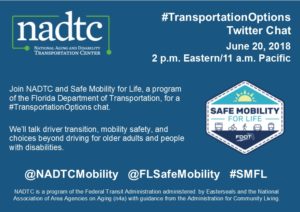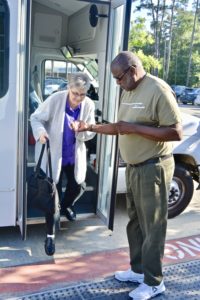Do You Know Your Accessible Transportation Options?
by Sydney

Join us for a Twitter chat to discuss more transportation options.
For people with disabilities and older adults across the country, transportation is key to independence including but not limited to running errands, social activities, and working. At Easterseals, we want to ensure that you know your options when it comes to getting from point A to point B. Check out our overview of transportation options below.
In addition to reviewing this list, be sure to check out the recap of the National Aging and Disability Transportation Center (NADTC) #TransportationOptions Twitter chat, which took place on June 20th.
The live chat will focus on driver safety, exploration of options beyond driving for older adults and people with disabilities, and how to share information on transportation options available in your community. We’ll post an archive of the questions and answers at www.nadtc.org after the chat.

Via Meals on Wheels
Demand response. Sometimes called Dial-a-Ride, demand response transports multiple passengers who are picked up from different entry points and dropped off at separate destinations. This service often
requires reservations to be made at least 24–48 hours in advance.
Medicaid Non-Emergency Medical Transportation (NEMT). NEMT is available to persons with Medicaid to travel to and from medical services. Eligibility criteria and types of destinations vary from state to state.
Public transit/fixed route transportation. Public transit agencies provide fixed route service by bus and rail along established routes with set schedules and no reservations required. Limited fixed route services may be available through other community agencies, such as trips to and from a Center for Independent Living or a senior center.
Paratransit. Paratransit must be offered by public transit agencies to individuals who are not able to use fixed route service. This is a requirement of the Americans with Disabilities Act (ADA). Paratransit is a complement to public transit, so must operate within ¾ of a mile of the fixed route and is available during the same hours as the fixed route service. Paratransit is a door-to-door service. A personal care attendant can travel with the passenger at no cost. To qualify for paratransit, riders need to meet specific eligibility requirements established under ADA.
Shared Ride Services (also known as Transportation Network Companies or TNCs). These
include Uber and Lyft and connect private pay passengers with drivers who provide transportation in
their own vehicles. These services do not typically offer wheelchair accessible vehicles or rider assistance. Passengers connect with drivers via websites or mobile apps on a smartphone and also pay for the services through a personal account on their phone. A growing number of communities offer access to shared ride services to older adults and people with disabilities through a scheduling phone line which may be operated by a nonprofit organization.
Taxi Services. Taxis are licensed vehicles that offer on-demand services to passengers. Trips usually can be scheduled in advance or on the spot, and fares are charged per mile or per minute. Many communities require taxi companies to have accessible vehicles in their fleets. Some community agencies offer taxi vouchers to older adults and people with disabilities who meet certain
eligibility criteria.
Travel Training. Public transit agencies and local aging and disability organizations provide free instruction to help new riders learn to travel safely on public transit. Travel training may be provided by professionals or peers who are experienced users of public transit. The training generally includes classroom instruction plus a group trip on transit.
Transportation Voucher Programs. Voucher programs provide fare assistance or free rides to low-income older adults and people with disabilities who meet the program’s eligibility criteria. Eligible riders usually receive vouchers for specific types of transportation. Voucher programs may offer rides only to certain destinations, such as medical appointments.
Volunteer Transportation Programs. These types of programs may be offered by local nonprofit and faith-based organizations. Drivers provide rides in their own cars or agency-owned vehicles for passengers to reach medical appointments or other important destinations. Rides are generally pre-arranged. Volunteer transportation programs may also offer door-to-door or door-through-door assistance. Some programs require riders to pay a small fee while others offer free rides.
More posts about transportation:







January 16th, 2020 at 7:06 pm
Good night,
I am reaching out becasue I had a strove in November 2019 and am unable to drive to my DR’s appointmtns. Is it at all possible I can sign up with your orginazation for transpotation assistance.
Thank you,
Andrea Barnes
June 26th, 2018 at 11:17 am
Do you provide vouchers fordisabled thru uber or lyft?